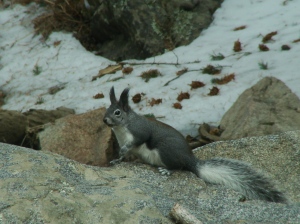Wintertime is harder on everyone. It’s cold, the days are shorter, and the weather can be downright unpleasant. Animals that inhabit temperate or arctic regions need some way
of dealing with winter in order to make a living during these cold months. Some may move to warmer locations, some simply hibernate, or enter a state of torpor, while others remain active all winter long. Even though we live in the Sonoran desert, several mountain ranges like the Pinaleños tower so high above the desert floor that they are covered in snow all winter. This means that even here in southern Arizona, animals living on mountain tops will have to deal with the physiological challenges that winter presents.
Tree squirrels don’t hibernate but remain active all winter long. This presents a physiological challenge because not only is the outside temperature much colder – requiring extra energy expenditure to
maintain a high mammalian body temperature – food is also scarce. Although tree squirrels do remain active, active is a relative term. One of the strategies tree squirrels use to cope with cold temperatures is to do what we all wish we could do in the winter – stay in bed. Tree squirrels aren’t really very well adapted to live in cold conditions. Their fur gets thicker but not greatly so, they put on more fat, but not huge amounts, and their resting metabolic rate remains high. Their strategy for coping then is threefold:
1. Put on brown adipose tissue, or fat. This tissue has more mitochondria, which are a cell’s energy factory. This tissue is thought to convert food consumed to body heat more quickly.
2. Eat fatty food. Yum! Tree seeds are very high in fat, which provides more energy for conversion to body heat.
3. Stay in bed! Yay! Studies have shown that nests are a critical resource tree squirrels need to cope with cold temperatures. Nests can be 20 – 30 degrees warmer than the temperature outside meaning that squirrels in a nest spend very little energy trying to keep warm. Red squirrels (Tamiasciurus hudsonicus) also drop their body temperature by a couple of degrees when they enter a nest, further reducing their energy
requirements. In addition to lining a nest with insulating materials such as lichen, grass, and fur, the type of nest a squirrel uses can also conserve energy. Squirrels can build nests out of grass, twigs, and leaves in the branches of a tree. This type of nest may not be as warm since it is more exposed to wind and weather. Squirrels use cavities in trees which are more protected from wind, snow, and sleet. Squirrels will also nest in tunnels they dig under the snow. At first this may not seem like a very warm option, but it takes advantage of a fact that mice and voles know very well – the layer between the ground and the bottom of the snowpack, or subnivian layer, stays a balmy 30 degrees F no matter what.
Because it is thermally advantageous to stay in the nest, squirrels face a trade off between
expending energy to find food and saving energy by staying warm and cozy in the nest. Because the days are shorter in winter, there are also fewer hours available for squirrels to forage. This is where larder hoarding species like red squirrels have an advantage over scatter hoarding species, like Abert’s squirrels (Sciurus aberti). Red squirrels invest a great deal of effort during the fall storing conifer cones in one centralized place – either in the ground or in their scale pile or midden. This means that red squirrels don’t have to go very far from their nest
to find their food. They can get up, eat,
bask in the sun for awhile, and then go back to bed. Telemetry studies confirm this decreased activity level; red squirrel winter home ranges are 4-5 times smaller than summer home ranges. Abert’s squirrels, on the other hand, cache their food in a dispersed manner all over the forest floor. They have to exert more energy searching for food they can find on the ground, which is often covered in snow, or eat less desirable foods like branch tips that they clip from trees.







Great information!! I have two rehabilitated tree squirrels in a release cage in my back yard in south Georgi, and it doesn’t usually get very cold here. But it was 19 degrees last night. When I checked on them today they were not active, but I’m hoping they were snuggling in the blanket in their nest box which is inside the release cage. I’m providing food so at least they don’t have to worry about that. hopefully they’ll reappear in the next day or so when the weather gets warmer!!
Hi Cheryl,
Sorry that I missed this comment earlier! I appreciate your feedback and glad that you found this entry useful. How are your rehabbed squirrels doing?